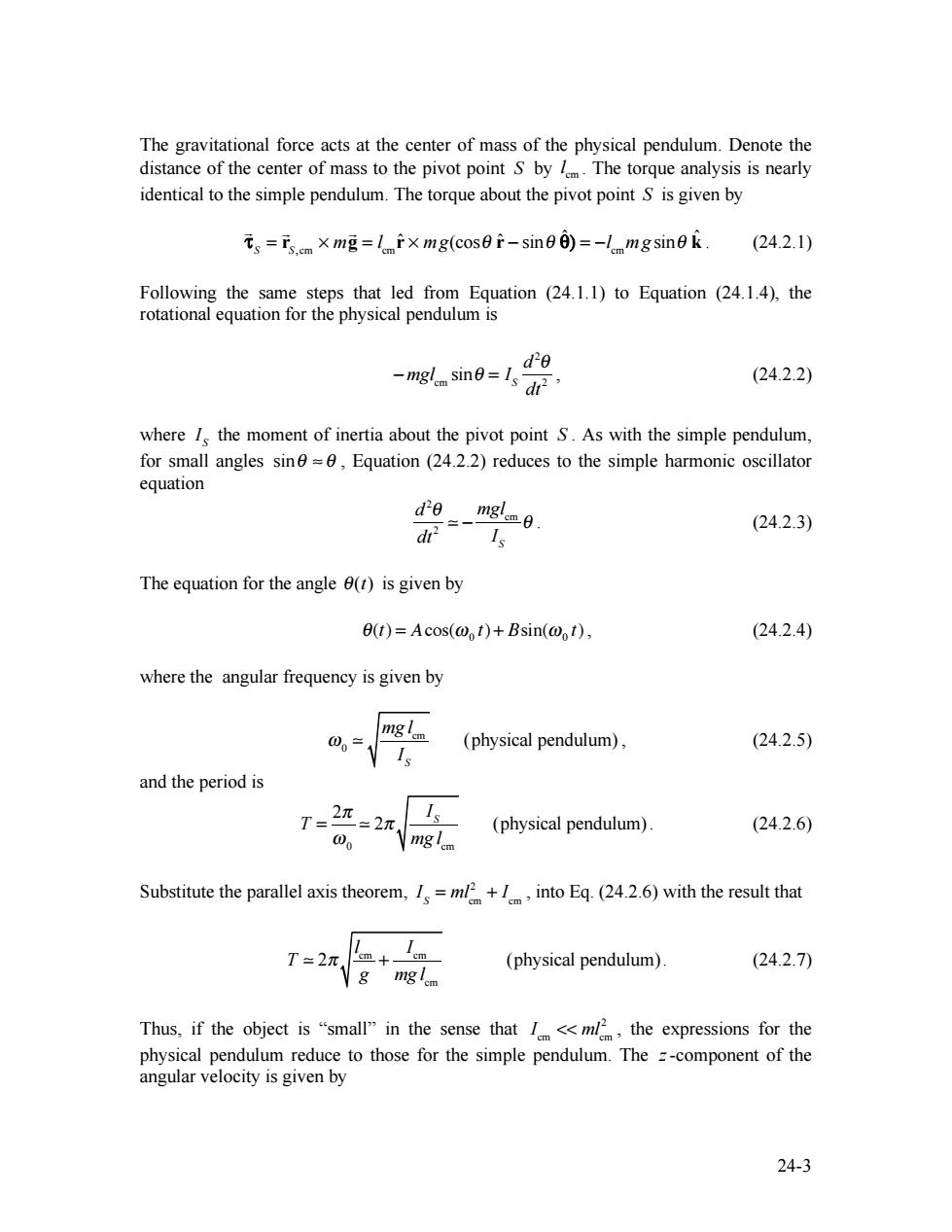正在加载图片...

The gravitational force acts at the center of mass of the physical pendulum.Denote the distance of the center of mass to the pivot point S by lem.The torque analysis is nearly identical to the simple pendulum.The torque about the pivot point S is given by 元、=s.m×mg=li×mg(cos0f-sin8)=-lmgsin0k (24.2.1) Following the same steps that led from Equation (24.1.1)to Equation (24.1.4),the rotational equation for the physical pendulum is -mgln sine-Is df d20 (24.2.2) where Is the moment of inertia about the pivot point S.As with the simple pendulum, for small angles sin=,Equation (24.2.2)reduces to the simple harmonic oscillator equation d'e mglem (24.2.3) Is The equation for the angle e(t)is given by 0(t)=Acos(@1)+Bsin(@1), (24.2.4) where the angular frequency is given by 0兰 mg lem (physical pendulum), (24.2.5) and the period is T= 2π (physical pendulum). (24.2.6) 00 mg lem Substitute the parallel axis theorem,I=minto Eq.(24.2.6)with the result that T=2π (physical pendulum). (24.2.7) Thus,if the object is "small"in the sense thatm the expressions for the physical pendulum reduce to those for the simple pendulum.The z-component of the angular velocity is given by 24-324-3 The gravitational force acts at the center of mass of the physical pendulum. Denote the distance of the center of mass to the pivot point S by cml . The torque analysis is nearly identical to the simple pendulum. The torque about the pivot point S is given by τ S = rS , cm × m g = l cmrˆ × mg(cosθ rˆ − sinθ ˆ θ) = −l cmmg sinθ kˆ . (24.2.1) Following the same steps that led from Equation (24.1.1) to Equation (24.1.4), the rotational equation for the physical pendulum is − mglcm sinθ = IS d2 θ dt 2 , (24.2.2) where IS the moment of inertia about the pivot point S . As with the simple pendulum, for small angles sinθ ≈θ , Equation (24.2.2) reduces to the simple harmonic oscillator equation d2 θ dt 2 − mglcm IS θ . (24.2.3) The equation for the angle θ(t) is given by θ(t) = Acos(ω0 t)+ Bsin(ω0 t), (24.2.4) where the angular frequency is given by ω0 mg l cm IS (physical pendulum) , (24.2.5) and the period is T = 2π ω0 2π IS mg l cm (physical pendulum). (24.2.6) Substitute the parallel axis theorem, IS = ml cm 2 + Icm , into Eq. (24.2.6) with the result that T 2π l cm g + Icm mg l cm (physical pendulum). (24.2.7) Thus, if the object is “small” in the sense that Icm << ml cm 2 , the expressions for the physical pendulum reduce to those for the simple pendulum. The z-component of the angular velocity is given by